Bobota
| |
|---|---|
  | |
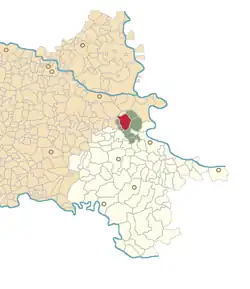 | |
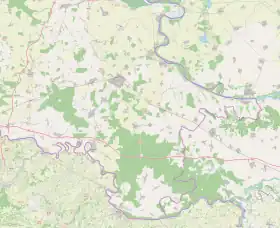 Bobota 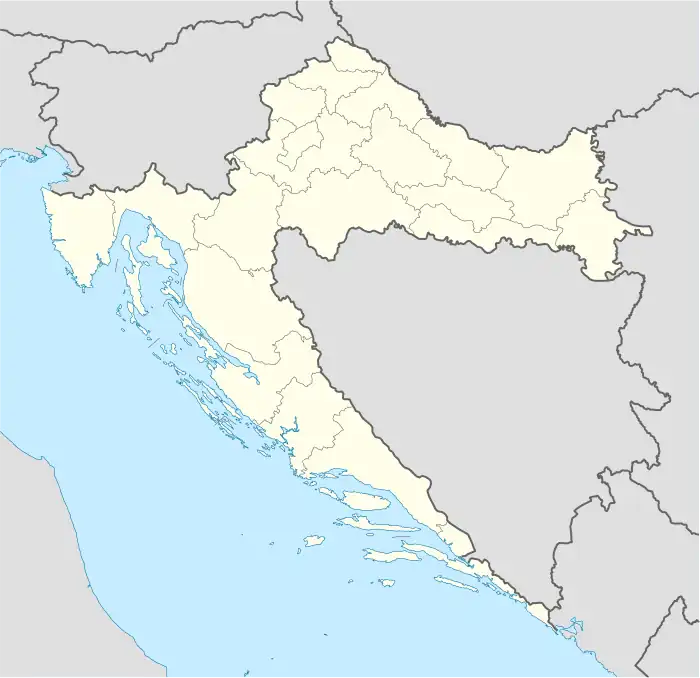 Bobota 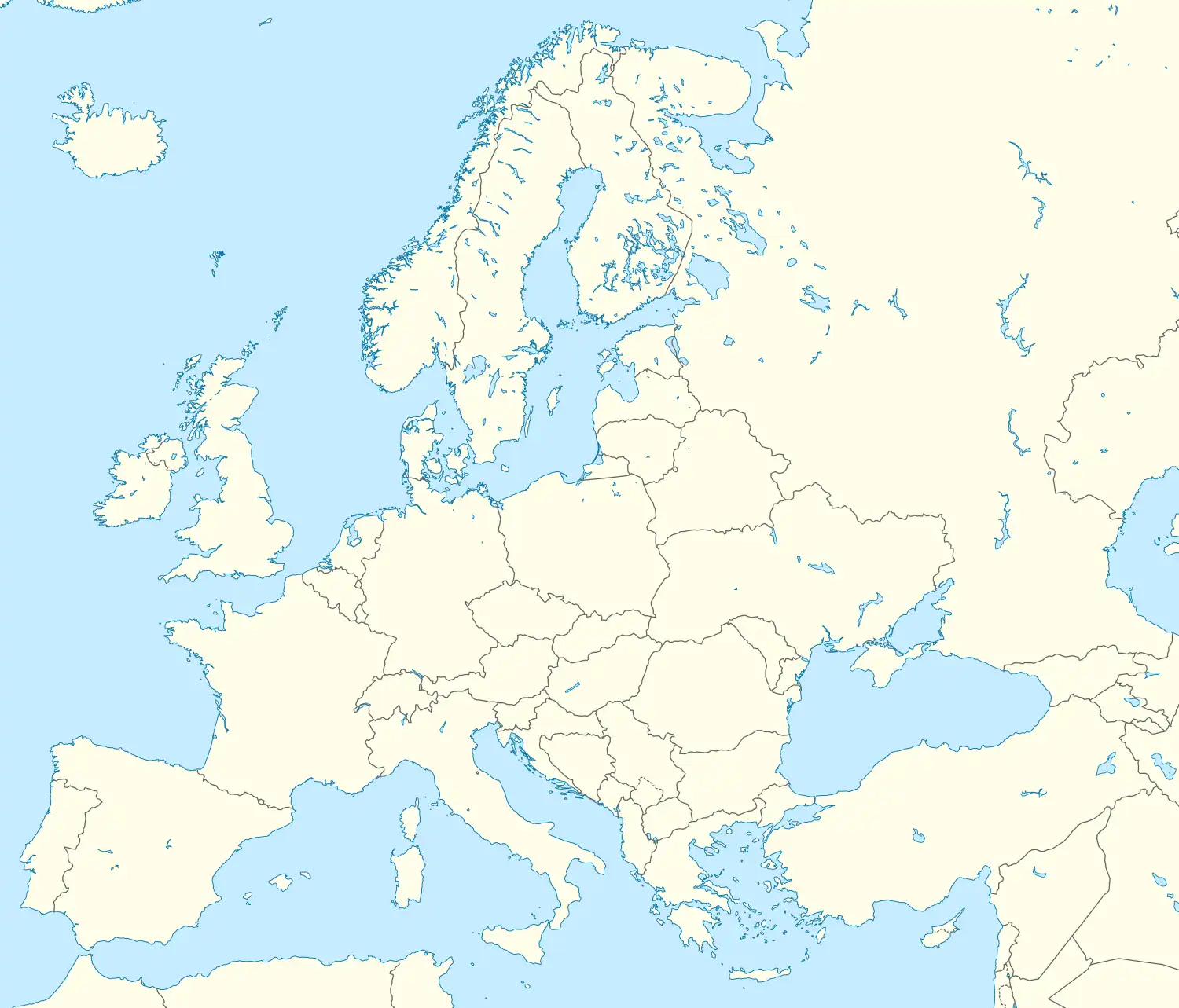 Bobota | |
| Coordinates: 45°23′45″N 18°51′19″E / 45.395934°N 18.855382°E | |
| Country | |
| Region | Slavonia (Podunavlje) |
| County | |
| Municipality | Trpinja |
| Government | |
| • Body | Local Committee |
| Area | |
| • Total | 34.6 km2 (13.4 sq mi) |
| Population (2021)[4] | |
| • Total | 1,202 |
| • Density | 35/km2 (90/sq mi) |
| Demonym(s) | Boboćanin (♂) Boboćanka (♀) (per grammatical gender) |
| Time zone | UTC+1 (CET) |
| • Summer (DST) | UTC+2 (CEST) |
| Postal code | 32 225 Bobota |
| Vehicle registration | VU |
| Official languages | Croatian, Serbian[2] |
Bobota (Serbian Cyrillic: Бобота)[5] is a village in the Municipality of Trpinja in Vukovar-Syrmia County in eastern Croatia. Regional Bobota Canal, the first major water management project in modern-day Croatia in the post-Roman Empire period, was named after the village.
According to 2011 Census Bobota, had a population of 1,491 inhabitants.[6] Bobota is centrally located within the municipality and is its largest settlement with its total population just marginally ahead of Trpinja. The village is located south of the D2 road and part of the Osijek Airport plot, including a part of the runway, is within its cadastral boundaries. The village is also located centrally in the triangle of the nearby cities of Osijek, Vukovar and Vinkovci.
Name
Villages of Trpinja, Bobota and Vera share the common folk story on the origin of their names. According to the story, the ancestors of today's inhabitants of villages, who settled at the time of the Great Serb Migrations under Arsenije III Čarnojević, were called Bobe. They fled from the Ottoman Empire conquests of Balkan in their effort to preserve their religious freedom.
This legendary religious commitment to Eastern Orthodoxy was coined in the local phrase of Bobe endured for the faith or originally in Serbian Bobe trpiše za veru. The family name of 'Bobe' was used as the basis for the name of Bobota, the word 'endured' (Serbo-Croatian: trpiti) for the name of Trpinja and from the word for faith (Serbian: vera) the name of Vera was created.[7]
Geography
Bobota, just slightly ahead of Trpinja, is the largest settlement in the municipality. Bobota is surrounded by Pačetin to the south, Ćelije to the west, Vera to the north and Trpinja, Lipovača and Bršadin to the east. Fertile intensive agricultural land and lowland forests are the main characteristics of the landscape. The Bobota Canal passes just north of the village separating a small part of it from the rest of the village.
History

The earliest recorded human settlement in the area of Bobota dates back to classical antiquity with the northeast archeologically site of Staro Ljeskovo containing IV century Roman bricks marked with "I H" inscription.[8] Those bricks indicate the presence of the Legio VI Herculia's station in the area at that time.[8] Other types of artefacts were discovered at the same location including Roman glazed ceramics, terra sigillata, glass and oil lamps with reliefs and a stone altar with the inscription of the tribune "Titus Flavius Marcianus" and with recognized potential for further archaeological excavations.[8]
According to primary written sources medieval village of Bobota existed under the name "Bobuta" as early as 1269 with medieval settlement being located slightly to the northwest on the left bank of the Vuka river, in a place called Stara Bobota. In 1366 "Babacha" was mentioned in a report to King Louis I of Hungary.[9] During the Ottoman–Hungarian wars the village was conquered in 1526 after the fall of Vukovar but it remained inhabited in 1558.[10] The village was liberated from the Ottoman rule in 1687 remaining uninhabited for the following ten years. The first 14 Serb families subsequently settled in the abandoned village building their homes close to the old village. In following years Serb settlement continued with families arriving from Bačka, Mačva, Montenegro and Baranya so that in 1736 there was already 82 households. The oldest book about Bobota was published in 1750.[11] Jewish family Wellisch (Velić) moved from Vukovar to Bobota in 1850s where they initiated their trade business with Leopold Wellisch (Lavoslav Velić) being born in the village in 1861 and died in Vienna in 1914.[12]
From 27 December 1920 (when they arrived in Vukovar) soldiers and families of the White Russian émigrés who were followers of Pyotr Wrangel settled in Bobota, Pačetin, Trpinja and Vera.[13]
Bobota was the first village in Vukovar region where Yugoslav Partisans resistance was organized during the World War II in Yugoslavia.[14] On 26 August 1941 local Ustaše representative was attacked under the leadership of Đoko Patković.[14] 96 residents of Bobota lost they lives during the World War II resulting in post-war reputation of the village as a regional stronghold of the resistance movement.[14] In the first years following the World War II in Yugoslavia and before 1948 Tito–Stalin split the new Yugoslavia implemented a number of policies copied from the Soviet Union including some aspects of collectivization in the Soviet Union. Rural resistance to this policy led to an incident in Bobota in 1945 when an anonymous humorous graffiti appeared in the village subsequently described by new authorities as an "enemy act by kulak elements".[15] The inscription, which rhyme in original language, stated "Kralju Petre, dođi nam do žetve, jer nam Tito odnese sve žito" or in English "King Peter, come before our harvest, because Tito took away all of our grain".[15] During the existence of the SFR Yugoslavia Bobota, nevertheless, gained reputation of comparatively prosperous village.[14]
On 22 July 1990 an All Serb Political Rally for Eastern Slavonia and Syrmia, event at which Jovan Rašković spoke, was held in Bobota leading to the establishment of the Serb Democratic Party (SDS) in the region where it was not active at the time of 1990 Croatian parliamentary election.[16] After the local branch of the Communist Party collectively joined the SDS, in October of 1990 300th anniversary of the Great Migrations of the Serbs was marked in the village with Matija Bećković attending the event.[17]
In late November 2021 Croatian media reported that investigators discovered human remains of at least ten victims from the Croatian War of Independence at the site of an illegal landfill located next to the forest close to the main road to Pačetin.[18]
Population
| population | 1921 | 2083 | 1945 | 2211 | 2140 | 2194 | 2198 | 2324 | 1852 | 1855 | 1940 | 1959 | 1926 | 1881 | 1651 |
| 1857 | 1869 | 1880 | 1890 | 1900 | 1910 | 1921 | 1931 | 1948 | 1953 | 1961 | 1971 | 1981 | 1991 | 2001 |
Serbs of Croatia constitute absolute majority of the local population.
Languages
Serbian language
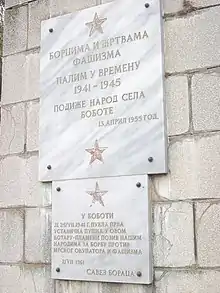
Serbian Language and Serbian Cyrillic alphabet is the second official language in most of the villages of the Municipality of Trpinja (except Ćelije) alongside the Croatian language which is official at the national level.[1] Both Serbian and Croatian language are standardized varieties of the pluricentric Serbo-Croatian language. According to the Municipal Statute, individuals who are members of the Serbian national minority are ensured the freedom of expression of national belonging and freedom to use their language and script in public and private use on the whole territory of the Municipality including the village of Bobota.[1] The statute guarantees that the Serbian Cyrillic alphabet will be used in the same font size as the Latin alphabet in the text of the local seals and stamps, on official plates of public representatives, executive and administrative bodies, as well as on those of legal persons with public authorities.[1]
According to the municipal Statute, bilingual signs of the same font are used for written traffic signs and other written traffic markings, street and squares names and names of settlement and geographical localities on the entire territory of the Municipality.[1] Equal public use of Serbian language is required on the basis of the Constitutional Act on the Rights of National Minorities in the Republic of Croatia and relevant national laws and the country is a party to the European Charter for Regional or Minority Languages.[2]
Economy
Agriculture is important source of economic revenue.
Education
Kindergarten Liliput
Local Liliput Kindergarten was formally registered on 29 March 1999.[20] Its central facilities are located in Bobota, with additional two branches in Bršadin and Trpinja.[20] Kindergarten is named after fictional island nation of Lilliput from the Gulliver's Travels book written by the Anglo-Irish writer and clergyman Jonathan Swift. Since the institution operate in villages where Serbs of Croatia constitute majority, it offers its program in Serbian with additional mandatory learning of Croatian.[20]
Primary school

Local public Primary School in Bobota provides education up to eighth grade. Institution offer classes in Serbian and Cyrillic. School also operate four branch schools in Pačetin, Vera, Klisa, and Ludvinci.[21] Those branch schools offer classes for pupils up to the fourth grade while higher grades student attend classes in Bobota. The school building in Bobota consists of two parts, one of which was built in 1928 and the other in 1975.[21] During the school year 2006/2007 new sports hall was built.[21] The school building has 8 classrooms, 7 specialized cabinets, two offices, library, staff room, toilets and central heating.[21] Furniture and educational equipment do not meet all standards due to deterioration and the lack of teaching resources.[21] School Library has in its possession approximately 5,000 items (books, CD-s, magazines).[22]
Associations and Institutions
Volunteer Fire Department Bobota is one of association active in the village.[23]
Sport
The village has a local football team called the NK "Borac" Bobota.



 Bobota Canal
Bobota Canal
See also
References
- 1 2 3 4 5 "Statut Općine Trpinja" (PDF). Retrieved 15 November 2022.
- 1 2 3 Government of Croatia (October 2013). "Peto izvješće Republike Hrvatske o primjeni Europske povelje o regionalnim ili manjinskim jezicima" (PDF) (in Croatian). Council of Europe. p. 36. Retrieved 15 November 2022.
- ↑ Register of spatial units of the State Geodetic Administration of the Republic of Croatia. Wikidata Q119585703.
- ↑ "Population by Age and Sex, by Settlements, 2021 Census". Census of Population, Households and Dwellings in 2021. Zagreb: Croatian Bureau of Statistics. 2022.
- ↑ "Minority names in Croatia: Registar Geografskih Imena Nacionalnih Manjina Republike Hrvatske" (PDF). Archived from the original (PDF) on 2013-10-29. Retrieved 2013-03-08.
- ↑ "Population by Age and Sex, by Settlements, 2011 Census: Bobota". Census of Population, Households and Dwellings 2011. Zagreb: Croatian Bureau of Statistics. December 2012.
- ↑ http://www.trpinja.hr/index.php?option=com_content&view=article&id=13&Itemid=26&lang=hr%5B%5D
- 1 2 3 "Arheološko nalazište "Staro Ljeskovo"". Retrieved 15 November 2022.
- ↑ "Diplomatikai levéltár 5451". Retrieved 15 November 2022.
- ↑ Csánki Dezső: Magyarország történelmi földrajza a Hunyadiak korában II. kötet – Valkó vármegye Bp. 1894.
- ↑ "Pravoslavni hramovi u Boboti i Bijelom Brdu". Srbi.hr, Joint Council of Municipalities. 20 April 2018. Retrieved 3 September 2021.
- ↑ Barišić Bogišić 2022, pp. 103.
- ↑ Barišić Bogišić 2022, pp. 232.
- 1 2 3 4 Filipović 2022, pp. 293.
- 1 2 Ivo Goldstein; Slavko Goldstein (2020). Tito [Tito] (in Croatian). Zagreb: Profil. p. 493. ISBN 978-953-313-750-6.
- ↑ Filipović 2022, pp. 297.
- ↑ Filipović 2022, pp. 298.
- ↑ "U Boboti pronađeni posmrtni ostaci deset osoba, smatra se da potječu iz Domovinskog rata". Hrvatska radiotelevizija. 26 November 2021. Retrieved 26 November 2021.
- ↑ Naselja i stanovništvo Republike Hrvatske 1857.-2001., www.dzs.hr Archived May 5, 2012, at the Wayback Machine
- 1 2 3 "Općina Trpinja-Dječji vrtić "Liliput-Trpinja"-O nama". Retrieved 5 August 2015.
- 1 2 3 4 5 "Osnovna škola Bobota-o školi". Retrieved 2 August 2015.
- ↑ "Osnovna škola Bobota-Knjižnica". Retrieved 2 August 2015.
- ↑ "Archived copy" (PDF). Archived from the original (PDF) on 2012-04-30. Retrieved 2011-10-15.
{{cite web}}: CS1 maint: archived copy as title (link)
Sources
- Barišić Bogišić, Lidija (2022). O neslavenskom stanovništvu na vukovarskom području. Hrvatska sveučilišna naklada. ISBN 978-953-169-497-1.
- Filipović, Vladimir (2022). "Srpska pobuna u selima vukovarske općine 1990. - 1991" [Serb Rebelion in the Villages of Vukovar Municipality 1990. - 1991.]. Scrinia Slavonica (in Croatian). Department for the History of Slavonia, Srijem and Baranja of the Croatian Institute of History. 22 (1): 291–319. doi:10.22586/ss.22.1.9. Retrieved 4 December 2022 – via Hrčak.


